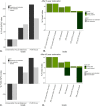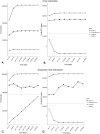Optimal restoration for pollination services increases forest cover while doubling agricultural profits
- PMID: 37220120
- PMCID: PMC10204975
- DOI: 10.1371/journal.pbio.3002107
Optimal restoration for pollination services increases forest cover while doubling agricultural profits
Abstract
Pollinators are currently facing dramatic declines in abundance and richness across the globe. This can have profound impacts on agriculture, as 75% of globally common food crops benefit from pollination services. As many native bee species require natural areas for nesting, restoration efforts within croplands may be beneficial to support pollinators and enhance agricultural yields. Yet, restoration can be challenging to implement due to large upfront costs and the removal of land from production. Designing sustainable landscapes will require planning approaches that include the complex spatiotemporal dynamics of pollination services flowing from (restored) vegetation into crops. We present a novel planning framework to determine the best spatial arrangement for restoration in agricultural landscapes while accounting for yield improvements over 40 years following restoration. We explored a range of production and conservation goals using a coffee production landscape in Costa Rica as a case study. Our results show that strategic restoration can increase forest cover by approximately 20% while doubling collective landholder profits over 40 years, even when accounting for land taken out of production. We show that restoration can provide immense economic benefits in the long run, which may be pivotal to motivating local landholders to undertake conservation endeavours in pollinator-dependent croplands.
Copyright: © 2023 López-Cubillos et al. This is an open access article distributed under the terms of the Creative Commons Attribution License, which permits unrestricted use, distribution, and reproduction in any medium, provided the original author and source are credited.
Conflict of interest statement
The authors have declared that no competing interests exist.
Figures






Similar articles
-
Pollination services to crops of watermelon (Citrullus lanatus) and green tomato (Physalis ixocarpa) in the coastal region of Jalisco, Mexico.PLoS One. 2024 Jul 23;19(7):e0301402. doi: 10.1371/journal.pone.0301402. eCollection 2024. PLoS One. 2024. PMID: 39042665 Free PMC article.
-
Forests are critically important to global pollinator diversity and enhance pollination in adjacent crops.Biol Rev Camb Philos Soc. 2023 Aug;98(4):1118-1141. doi: 10.1111/brv.12947. Epub 2023 Mar 6. Biol Rev Camb Philos Soc. 2023. PMID: 36879466 Review.
-
Forest spatial configuration and local management influence bee pollinator biodiversity in urban and rural landscapes.J Environ Manage. 2025 Mar;377:124672. doi: 10.1016/j.jenvman.2025.124672. Epub 2025 Feb 23. J Environ Manage. 2025. PMID: 39993359
-
Landscape and local site variables differentially influence pollinators and pollination services in urban agricultural sites.PLoS One. 2019 Feb 13;14(2):e0212034. doi: 10.1371/journal.pone.0212034. eCollection 2019. PLoS One. 2019. PMID: 30759171 Free PMC article.
-
Pollinator nutrition and its role in merging the dual objectives of pollinator health and optimal crop production.Philos Trans R Soc Lond B Biol Sci. 2022 Jun 20;377(1853):20210170. doi: 10.1098/rstb.2021.0170. Epub 2022 May 2. Philos Trans R Soc Lond B Biol Sci. 2022. PMID: 35491607 Free PMC article. Review.
Cited by
-
Understanding interactive effects between habitat configuration and pesticide use for pollination: towards better informed landscape management.Ecol Process. 2025;14(1):25. doi: 10.1186/s13717-025-00587-z. Epub 2025 Mar 3. Ecol Process. 2025. PMID: 40045945 Free PMC article.
-
From marginal croplands to natural habitats: A methodological framework for assessing the restoration potential to enhance wild-bee pollination in agricultural landscapes.Landsc Ecol. 2024;39(11):194. doi: 10.1007/s10980-024-01993-y. Epub 2024 Nov 12. Landsc Ecol. 2024. PMID: 39539641 Free PMC article.
References
-
- Suding K, Higgs E, Palmer M, Callicott JB, Anderson CB, Baker M, et al.. Committing to ecological restoration. Science. 2015;348(6235):638–40. - PubMed
-
- Bonn C. Restoration commitments from Africa push the Bonn Challenge beyond 100 million hectares. Bonn Challenge. 2016.
-
- Kanianska R. Agriculture and Its Impact on Land-Use, Environment, and Ecosystem Services. IntechOpen; 2016.
Publication types
MeSH terms
LinkOut - more resources
Full Text Sources
Research Materials

